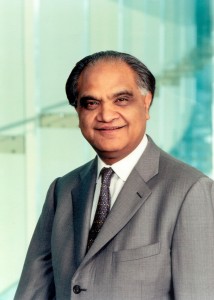Should HR be split?
An article by Mr. Ram Charan in the Harvard Business Review and its counter article by Dave Ulrich gave that ‘split’ a thought.
Ram Charan is a business advisor to CEOs and corporate boards, and coauthor of the new book, Boards That Lead, with Dennis Carey and Michael Useem. His views –
 I talk with CEOs across the globe who are disappointed in their HR people. They would like to be able to use their chief human resource officers (CHROs) the way they use their CFOs—as sounding boards and trusted partners—and rely on their skills in linking people and numbers to diagnose weaknesses and strengths in the organization, find the right fit between employees and jobs, and advise on the talent implications of the company’s strategy.
I talk with CEOs across the globe who are disappointed in their HR people. They would like to be able to use their chief human resource officers (CHROs) the way they use their CFOs—as sounding boards and trusted partners—and rely on their skills in linking people and numbers to diagnose weaknesses and strengths in the organization, find the right fit between employees and jobs, and advise on the talent implications of the company’s strategy.
But it’s a rare CHRO who can serve in such an active role. Most of them are process-oriented generalists who have expertise in personnel benefits, compensation, and labor relations. They are focused on internal matters such as engagement, empowerment, and managing cultural issues. What they can’t do very well is relate HR to real-world business needs. They don’t know how key decisions are made, and they have great difficulty analyzing why people—or whole parts of the organization—aren’t meeting the business’s performance goals.
Among the few CHROs who do know, I almost always find a common distinguishing quality: They have worked in line operations—such as sales, services, or manufacturing—or in finance. The celebrated former CHRO of GE, Bill Conaty, was a plant manager before Jack Welch brought him into HR. Conaty weighed in on key promotions and succession planning, working hand in glove with Welch in a sweeping overhaul of the company. Mary Anne Elliott, the CHRO of Marsh, had had several managerial roles outside HR. She is overhauling the HR pipeline to bring in other people with business experience. Santrupt Misra, who left Hindustan Unilever to join Aditya Birla Group in 1996, became a close partner of the chairman, Kumar Mangalam Birla, working on organization and restructuring and developing P&L managers.
My proposal is radical but grounded in practicality: Split HR into two strands.
Such people have inspired the solution I have in mind. It is radical, but it is grounded in practicality. My proposal is to eliminate the position of CHRO and split HR into two strands. One—we might call it HR-A (for administration)—would primarily manage compensation and benefits. It would report to the CFO, who would have to see compensation as a talent magnet, not just a major cost. The other, HR-LO (for leadership and organization), would focus on improving the people capabilities of the business and would report to the CEO.
 HR-LO would be led by high potentials from operations or finance whose business expertise and people skills give them a strong chance of attaining the top two layers of the organization. Leading HR-LO would build their experience in judging and developing people, assessing the company’s inner workings, and linking its social system to its financial performance. They would also draw others from the business side into the HR-LO pipeline. After a few years these high potentials would move to either horizontal or higher-level line management jobs. In either case they would continue to rise, so their time in HR-LO would be seen as a developmental step rather than a ticket-punching exercise.
HR-LO would be led by high potentials from operations or finance whose business expertise and people skills give them a strong chance of attaining the top two layers of the organization. Leading HR-LO would build their experience in judging and developing people, assessing the company’s inner workings, and linking its social system to its financial performance. They would also draw others from the business side into the HR-LO pipeline. After a few years these high potentials would move to either horizontal or higher-level line management jobs. In either case they would continue to rise, so their time in HR-LO would be seen as a developmental step rather than a ticket-punching exercise.
This proposal is just a bare outline. I expect to see plenty of opposition to it. But the problem with HR is real. One way or another, it will have to gain the business acumen needed to help organizations perform at their best.
The Counter
Dave Ulrich is the Rensis Likert Professor of Business at the Ross School, University of Michigan, and a partner at the RBL Group. He studies how organizations build capabilities of leadership, speed, learning, accountability, and talent through human resources.
 Ram Charan’s recent column “It’s Time to Split HR” has created quite a stir. While I have enormous respect for Ram’s wisdom, I believe CHROs have much to offer CEOs and can be better prepared to do so without splitting HR.
Ram Charan’s recent column “It’s Time to Split HR” has created quite a stir. While I have enormous respect for Ram’s wisdom, I believe CHROs have much to offer CEOs and can be better prepared to do so without splitting HR.
Much of Charan’s recent work has tilted towards organization and people (books on strategy execution, leadership pipeline, talent and advice on intensity, change, leadership traits, performance management, governance). I believe that Charan’s perspective reflects an increasing emphasis among business leaders on the organizational capabilities required to win. Charan has turned his attention to these organization dynamics in response to CEOs recognizing that technology, operations, access to financial capital, and even strategic positioning statements are less differentiating than their organization’s ability to respond to opportunities. As business leaders demand more of their organization, they look for counsel to create more competitive organizations, thus raising the bar on HR. Charan’s latest column actually affirms the value of HR to sustained competitiveness.
More is now expected of HR professionals. Charan (intentionally or not) lambasts the entire HR profession (“It’s time to say good bye to the Department of Human Resources”). This is both unfair and simplistic. It ignores what I call the 20-60-20 rule. In HR (or finance or IT), 20% of the professionals are exceptional, adding value that helps organizations move forward, 20% of HR folks are locked into a fixed mindset and lack either competence or commitment to deliver real value, and 60% are in the middle. It is easy and fair to critique the bottom 20%, but it is not fair to paint the entire profession with this same brush. I tend not to focus on either 20%. The top 20% are exceptional and don’t need help. They should be role models for others. Charan noted a few of these folks in his column. The bottom 20% won’t take help. But, the 60% seem, in my view, to be actively engaged in learning how to help their organizations improve. Sometimes they are stymied by their own lack of ability, but I find that often they are also limited by senior leaders who don’t appreciate the value they offer. I advocate teaching the 60% what they can do to deliver value even in difficult circumstances (working with non-supportive leaders or in difficult markets, for example).
As HR professionals engage with business leaders to deliver value, the conversation should not just be about talent. The top 20% today (and I hope more of the 60% tomorrow) focus on three things: talent, leadership, and capability, along with their attributes:
Charan’s advocacy for a “talent” HR role actually limits the breadth of what HR can and should deliver. When HR professionals bring unique insights about talent, leadership, and capability to the senior management dialogue, they add enormous value. I suggest that HR professionals are better at delivering in each of these areas than line managers who get moved into HR roles—the path Charan recommends.
Charan’s recommendation for splitting HR into two groups raises two concerns. First, it offers a simplistic structural solution to the fundamental challenge of increasing HR’s value to the business. I am a little surprised that Charan, who is known for his integrated strategic approach to business, has reduced the HR challenge to a governance problem. Upgrading HR requires more rigorous redefinition of how HR can deliver value, how to develop HR professionals, and how to rethink the entire system of HR.
Second, advocating the separation of the HR function into two groups cannot be a blanket solution to HR governance. The structure of the HR department should be tied to the business structure (a centralized business should not have divided HR governance nor should a pure holding company). In diversified organizations HR departments should be run like professional services firms. This approach offers the benefits of centralization (efficiency, economy of scale) and decentralization (effectiveness, local responsiveness). In fact, many large diversified organizations have separated HR into three groups: the embedded HR generalists who work with business leaders on talent, leadership, and capabilities; centers of expertise that offer analytics and insights into HR knowledge domains; and service centers that do the administrative work of HR. All can be governed under the HR umbrella–just the way finance and accounting or marketing and sales work together.
I suggest a holistic approach to helping the middle 60%. This includes redefining the strategy (outside-in) and outcomes (talent, leadership, and capability) for HR, redesigning the organization (department structure), innovating HR practices (people, performance, information, and work), upgrading the competencies for HR professionals, and focusing HR analytics on decisions more than data. It is not easy to move a profession forward. The top 20% don’t always share their lessons in ways that teach others. The bottom 20% get too much attention. And, the vast middle gets discouraged when respected colleagues (unintentionally, I believe) belittle them and their efforts. We can do better than this.
Both the thoughts have brought us face to face at certain starting truths.


 27. Nov, 2014
27. Nov, 2014 






No comments yet... Be the first to leave a reply!